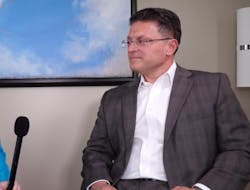Michael Bakas, executive vice president, Ameresco, describes the benefits of green campus microgrids. Such projects help campuses reach sustainability markers, as well as economic goals when they are financed through energy performance contracts. In addition, campus microgrids can serve as learning labs that give graduating students a leg up in the job market. Elisa Wood, Microgrid Knowledge editor-in-chief, spoke with Bakas at Microgrid 2019 in San Diego.
More and more campuses — whether they serve healthcare, higher education or industry — are building microgrids.
What’s the impetus for this trend in campus microgrids?
Bakas said that campuses are trying to leverage microgrids to address resiliency challenges, as well hedge against the volatility the industry is seeing in energy demand.
Wood pointed out that higher education campuses often have aggressive sustainability goals, yet they use combined heat and power (CHP) plants that operate on fossil fuels.
How can these campuses achieve goals, for example, to achieve 100% green energy, and also take advantage of the efficiencies of CHP?
Bakas explained that more than half of the carbon footprint of a lot of campuses, especially in higher education, comes from the combustion of fossil fuels.
“One way to address this, especially with cogeneration, is to actually use renewable natural gas to displace the fossil fuel,” Bakas said, essentially “greening” the output from the generation facility.
Renewable natural gas facility in Phoenix. Courtesy of Ameresco
Renewable natural gas, Bakas said, is a byproduct of facilities that produce biogas, such as a wastewater treatment plant. Or biogas may come from a landfill. It’s a gas already in the environment that can be processed, injected into a natural gas interstate pipeline and transported anywhere in the country.
“This effectively offsets the environmental challenges of choosing a sequestered product, like natural gas, and extracting it directly from the earth,” Bakas pointed out.
Use of renewable natural gas also serves the popular trend of installing electric vehicle charging stations on campuses. Although electric vehicles may sound green, they may not be. You have to take a look upstream at the actual fuel source for the electricity, Bakas said.
“By using renewable natural gas to generate electric and thermal and using that electricity for the charging stations for electric vehicles, they are truly getting green from end-to-end,” he said.
“The microgrid acts as the glue to some extent, pulling all these distributed energy resources together to help optimize those other investments, whether its CHP, or battery storage, or solar,” Michael Bakas, Ameresco
So, how can college campuses, in particular, even afford to implement a microgrid?
Many are turning to energy performance contracts, Bakas said. This approach pays for the project through energy savings, limiting or eliminating the need for the campus to make an upfront capital investment.
“The microgrid acts as the glue to some extent to pulling all these distributed energy resources together to help optimize those other investments, whether its CHP, of battery storage, or solar,” Bakas said.
Ultimately, campus microgrids can integrate all of these resources to optimize performance, efficiency and stability at institutions to which resiliency and uptime is key.
Track microgrid news and trends as they emerge. Subscribe to the free Microgrid Knowledge newsletter.







